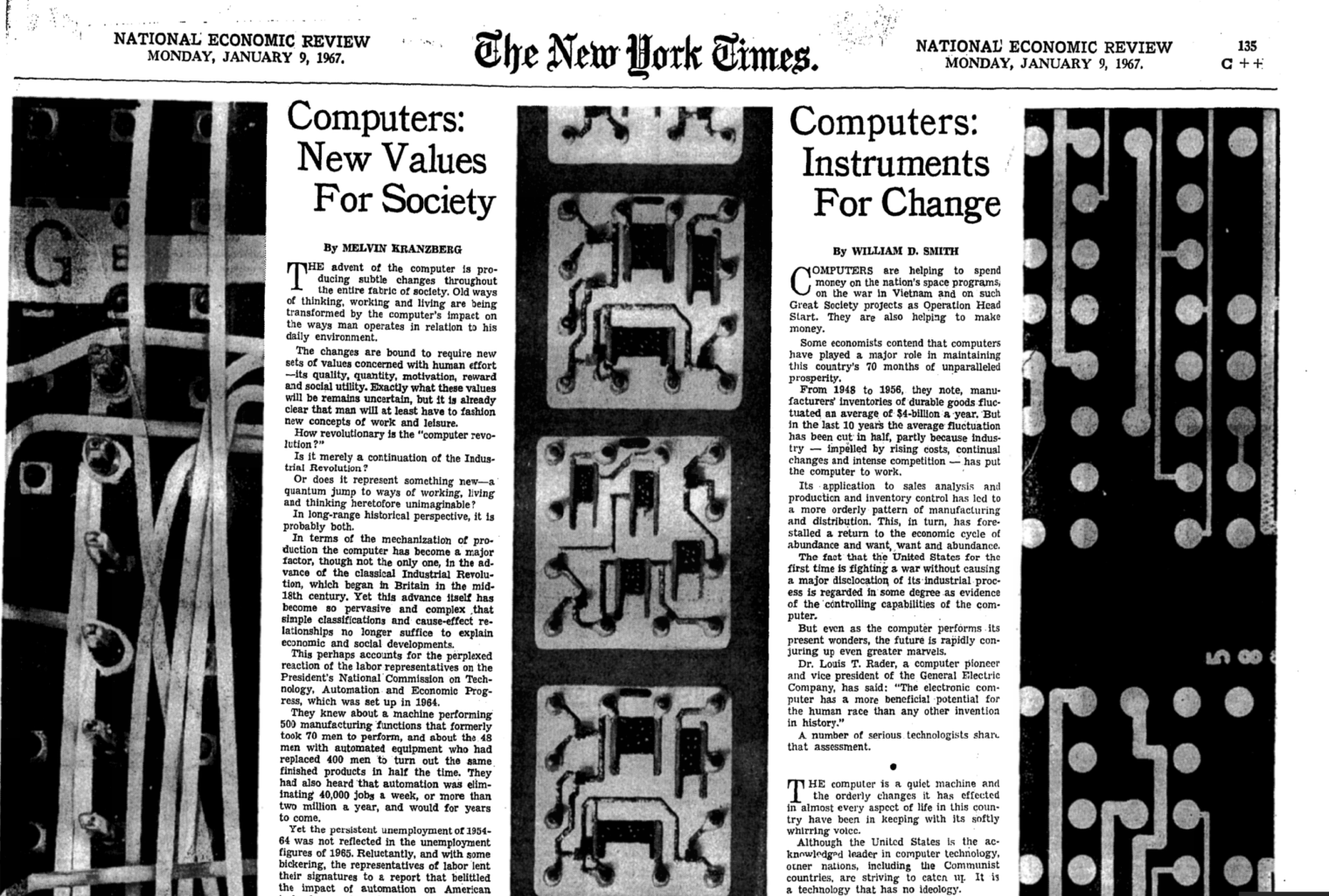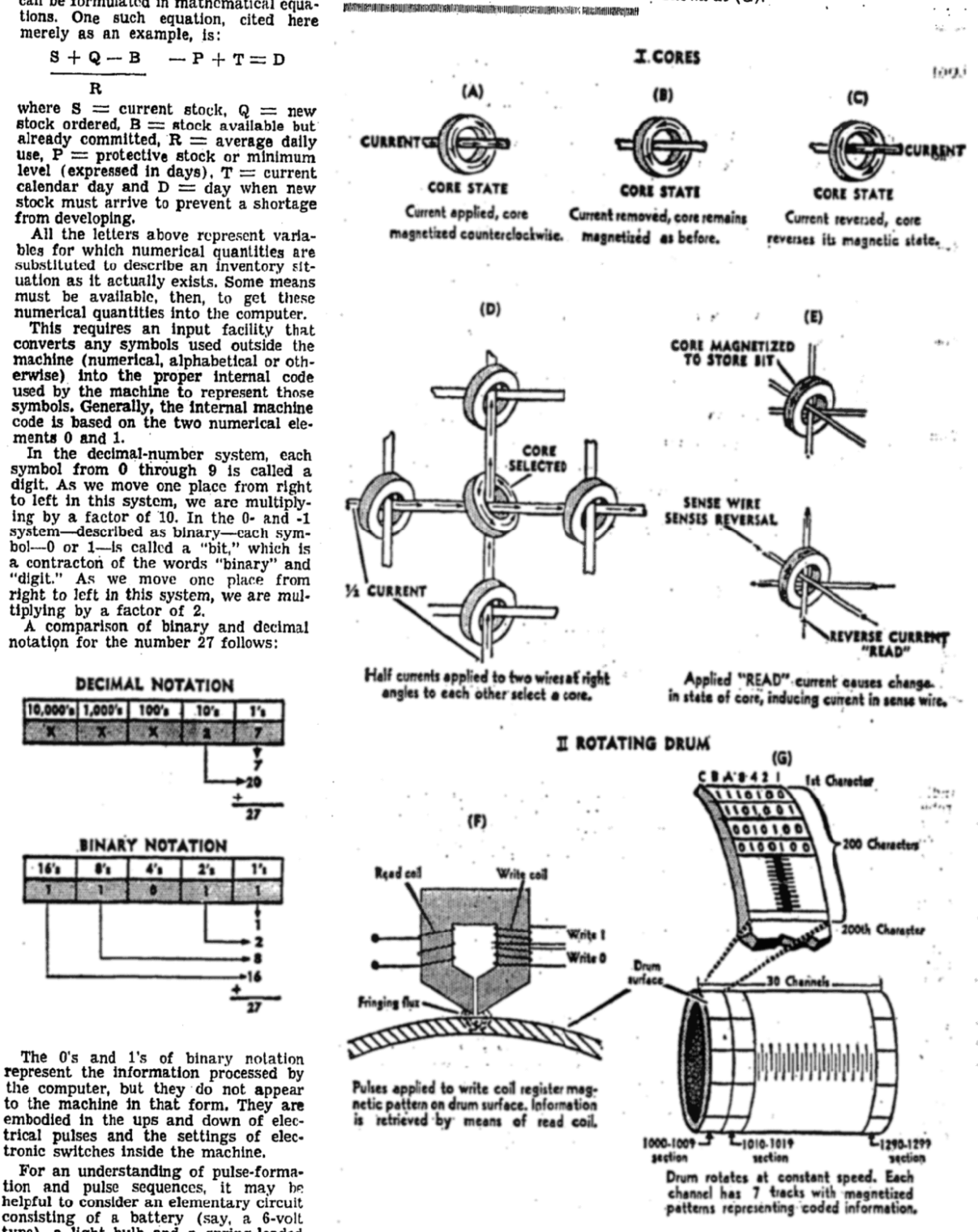Americans today love to read about cosmology and string theory, but you couldn’t pay most to listen to a lecture on how their beloved smartphones work. Apparently, there was a time when non-specialists were interested in “How does this computer thing work?” On Monday, January 9, 1967, the New York Times devoted a two-page spread to “The Electronic Digital Computer: How It Started, How It Works and What It Does”.
This article is preceded by a couple of softer pieces that talk about what can be done with computers. Every page includes “C++” up in the header, thus proving that the NYT can accurately predict the future.
The science writer, Henry Lieberman, is helped out by Louis Robinson, an IBMer, and they explain binary as well as mainframe core and magnetic memory:
Everything you need to know to be a TTL hero:
Source code compiled into machine language:
Universal access to computing is predicted:
And so is the Internet (sort of):
Page 139 carries a predictive article by J. C. R. Licklider about how scientists will use computers to deal with “big data” and there will be “vast information networks”. In several locations, including page 143 (out of 172; imagine a hardcopy newspaper able to sell so many ads these days to justify printing 172 pages!), journalists write breathlessly about how computers will transform education.
John Backus, who would win a Turing Award 10 years later, encourages would-be programmers on page 148:
Note the picture of high school students learning to code.
What about salaries and costs? An “Airline Clerk” is sought on page 165 and will earn $5,200 per year. On 167, a machinist can earn $6,700/year in the Bronx while a dry cleaning manager would be at $10,000/year. Page 160 shows apartments for rent in Manhattan. It looks like $100-200/month is the range for a studio or 1BR. So the clerk could easily live without roommates in the heart of the city.







” It looks like $100-200/month is the range for a studio or 1BR. So the clerk could easily live without roommates in the heart of the city.”
Interpretation one: The stereotypical sitcom with a young 20 something blue collar affording Manhattan rent is not wrong on location, only on time period!
Interpretation 2: For that rent level, they get Charles Bronson’s “Death Wish” Big Apple, or should I say Gotham City?
In mid – 1990th one bedroom apartment in older building with a concierge in lower midtown east side Manhattan was priced around $70,000. Something that was in a price range for LSI back than, but you could not give it me for free to live there, looked like darwinian dead end to me back than. Crime was not particularly noticeable in Manhattan back than.
I have to show this to my father, he’ll get a big kick out of it and it’ll take him right back to his System/360 days.
I was talking with him today about your earlier post, and he told me a funny (and harrowing) story about Information Security from his days working for IBM at Equitable Trust. It has to do with a disgruntled employee who successfully destroyed five levels of their tape backups of transaction records…which were stored in a vault. He had access to the vault. He also had access to the building with a wave and a nod.
I’ll put that in the appropriate thread, but he told me: “After that, Equitable Trust got serious about security. You could no longer walk back into the building by just saying “Hello” to the security guard who knew you.”
I think the Statute of Limitations has expired on that one and it’s a fun story.
A logic diagram would be equivalent to any viral gootube video today, but definitely not the NYT. Viral gootube videos are just based on what people from 20-35 are watching. On the other paw, the huge viral videos aren’t Ben Eater’s low level logic diagrams but soft science.
Pretty amazing writing. I find that the closer publications are to original discoveries, the better the presentations. After that everything is watered down and “simplified” by teachers.
(If anyone knows the best original authors in machine learning and neural networks, I’d be thrilled to know. There seems to be an infinite amount of insignificant papers and it is hard to find the ones that matter.)
Anonymous,
Fuzzy Engineering by Dr. Bart Kosko is probably one of the best original books
https://www.amazon.com/Fuzzy-Engineering-Bart-Kosko/dp/0131249916
Here is a link to Dr. Bart Kosko website at USC, his journal articles are also very good.
https://sipi.usc.edu/~kosko/
Time sharing is definitely the way to go. Predicting the future is easy.